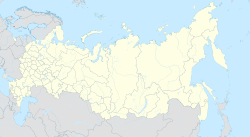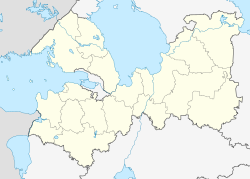world.wikisort.org - Russia
Lesogorsky (Russian: Лесого́рский; Finnish: Jääski; Swedish: Jäskis) is an urban locality (an urban-type settlement) in Vyborgsky District of Leningrad Oblast, located on the left bank of the Vuoksi River, on the Karelian Isthmus, near the Russia–Finland border, and a station of the Kamennogorsk–Svetogorsk–Imatra railway. Population: 3,273 (2010 Census);[3] 3,004 (2002 Census);[8] 3,744 (1989 Census).[9]
Lesogorsky
Лесогорский | |
|---|---|
Urban-type settlement[1] | |
 Valf manor, a building by Uno Ullberg | |
 Coat of arms | |
Location of Lesogorsky  | |
 Lesogorsky Location of Lesogorsky  Lesogorsky Lesogorsky (Leningrad Oblast) | |
| Coordinates: 61°03′N 28°55′E | |
| Country | Russia |
| Federal subject | Leningrad Oblast |
| Administrative district | Vyborgsky District[1] |
| Urban-type settlement status since | 1940[2] |
| Population | |
| • Total | 3,273 |
| • Estimate (2018)[4] | 3,208 (−2%) |
Municipal status | |
| • Municipal district | Vyborgsky Municipal District[5] |
| • Urban settlement | Svetogorskoye Urban Settlement[5] |
| Time zone | UTC+3 (MSK |
| Postal code(s)[7] | |
| OKTMO ID | 41615114056 |
Municipally, Lesogorsky together with the town of Svetogorsk form Svetogorskoye Urban Settlement of Vyborgsky Municipal District.
History
Early history
Jääski was first mentioned in 1323 in the Treaty of Nöteborg as one of the three pogosts given to Sweden by Novgorod, the other two being Äyräpää and Savilahti (Mikkeli).
Ruokolahti was a part of the Jääski parish until 1572, while Joutseno was a part of the Jääski parish until 1639.[10]
Acquisition by Russia
Russia acquired the area in 1721 after the Great Northern War in the Treaty of Nystad. Until 1918 it was a part of Vyborg Governorate, which after 1812 belonged to the Grand Duchy of Finland and was known as the Viipuri Province.
Finnish rule

In 1917, Finland became independent, and the town became the administrative center of the Jääski municipality of the Viipuri Province.[11] The industrial area of Enso, later Svetogorsk, was also a part of Jääski.

Soviet and Russian rule
The territory had been ceded by Finland to the Soviet Union by the Moscow Peace Treaty as a result of the Winter War. It was recaptured by Finns between 1941 and 1944 during Continuation War but was again ceded to Soviets after Moscow Armistice. This secession was formalized after signing Paris Peace Treaty in 1947. The Viipuri Province was divided, with the larger part ceded to Soviet Union and the smaller part remaining in Finland. The population was resettled to Finland, mainly to Elimäki, Anjala and Kuusankoski,[12] while people from Central Russia were resettled to populate the Karelian Isthmus.[2] The northwesternmost parts of the Jääski municipality remained Finnish and were mainly used to form Imatra.
In March 1940 Yaskinsky District with the administrative center in Jääski was established, and Jääski obtained work settlement status. The district was a part of the Karelian Autonomous Soviet Socialist Republic, after March 31, 1940 of the Karelo-Finnish Soviet Socialist Republic.[2] On November 24, 1944, Yaskinsky District was transferred from Karelo-Finnish Soviet Socialist Republic to Leningrad Oblast. On October 1, 1948 the district was renamed Lesogorsky, and on January 13, 1949 Jääski was renamed Lesogorsky. On December 9, 1960 Lesogorsky District was abolished and merged into Vyborgsky District.[13]
Economy
Industry
In Lesogorsky, there is a plant producing plastic and fibers. There is a power plant on the Vuoksi.
Transportation
Lesogorsky is connected by railway with Kamennogorsk, where it has connection to the old Vyborg–Joensuu railroad. There is suburban traffic to Vyborg. The continuation of the railroad beyond Svetogorsk to the state border is disused.
Lesogorsky is connected by roads with Kamennogorsk and Vyborg, as well as with Imatra across the border via Svetogorsk.
References
Notes
- Государственный комитет Российской Федерации по статистике. Комитет Российской Федерации по стандартизации, метрологии и сертификации. №ОК 019-95 1 января 1997 г. «Общероссийский классификатор объектов административно-территориального деления. Код 41 215 554 006», в ред. изменения №278/2015 от 1 января 2016 г.. (State Statistics Committee of the Russian Federation. Committee of the Russian Federation on Standardization, Metrology, and Certification. #OK 019-95 January 1, 1997 Russian Classification of Objects of Administrative Division (OKATO). Code 41 215 554 006, as amended by the Amendment #278/2015 of January 1, 2016. ).
- История Выборгского района, история Выборгской земли (in Russian). Муниципальное образование Выборгский район Ленинградской Области. Retrieved May 16, 2013.
- Russian Federal State Statistics Service (2011). Всероссийская перепись населения 2010 года. Том 1 [2010 All-Russian Population Census, vol. 1]. Всероссийская перепись населения 2010 года [2010 All-Russia Population Census] (in Russian). Federal State Statistics Service.
- "26. Численность постоянного населения Российской Федерации по муниципальным образованиям на 1 января 2018 года". Federal State Statistics Service. Retrieved January 23, 2019.
- Law #17-oz
- "Об исчислении времени". Официальный интернет-портал правовой информации (in Russian). June 3, 2011. Retrieved January 19, 2019.
- Почта России. Информационно-вычислительный центр ОАСУ РПО. (Russian Post). Поиск объектов почтовой связи (Postal Objects Search) (in Russian)
- Russian Federal State Statistics Service (May 21, 2004). Численность населения России, субъектов Российской Федерации в составе федеральных округов, районов, городских поселений, сельских населённых пунктов – районных центров и сельских населённых пунктов с населением 3 тысячи и более человек [Population of Russia, Its Federal Districts, Federal Subjects, Districts, Urban Localities, Rural Localities—Administrative Centers, and Rural Localities with Population of Over 3,000] (XLS). Всероссийская перепись населения 2002 года [All-Russia Population Census of 2002] (in Russian).
- Всесоюзная перепись населения 1989 г. Численность наличного населения союзных и автономных республик, автономных областей и округов, краёв, областей, районов, городских поселений и сёл-райцентров [All Union Population Census of 1989: Present Population of Union and Autonomous Republics, Autonomous Oblasts and Okrugs, Krais, Oblasts, Districts, Urban Settlements, and Villages Serving as District Administrative Centers]. Всесоюзная перепись населения 1989 года [All-Union Population Census of 1989] (in Russian). Институт демографии Национального исследовательского университета: Высшая школа экономики [Institute of Demography at the National Research University: Higher School of Economics]. 1989 – via Demoscope Weekly.
- "SuomalainenPaikannimikirja_e-kirja_kuvallinen.pdf" (PDF). kaino.kotus.fi (in Finnish). p. 374+386. Retrieved August 20, 2022.
{{cite web}}: CS1 maint: url-status (link) - Лесогорское городское поселение (in Russian). ucoz.ru. Retrieved June 3, 2013.
- "Jääsken pitäjän historiaa - Karjalan Liitto". karjalanliitto.fi (in Finnish). Retrieved August 22, 2022.
{{cite web}}: CS1 maint: url-status (link) - Яскинский район (нояб.1944 - окт.1948), Лесогорский район (окт.1948 - дек.1960) (in Russian). Система классификаторов исполнительных органов государственной власти Санкт-Петербурга. Archived from the original on March 20, 2014. Retrieved May 16, 2013.
Sources
- Законодательное собрание Ленинградской области. Областной закон №32-оз от 15 июня 2010 г. «Об административно-территориальном устройстве Ленинградской области и порядке его изменения», в ред. Областного закона №23-оз от 8 мая 2014 г. «Об объединении муниципальных образований "Приморское городское поселение" Выборгского района Ленинградской области и "Глебычевское сельское поселение" Выборгского района Ленинградской области и о внесении изменений в отдельные Областные законы». Вступил в силу со дня официального опубликования. Опубликован: "Вести", №112, 23 июня 2010 г. (Legislative Assembly of Leningrad Oblast. Oblast Law #32-oz of June 15, 2010 On the Administrative-Territorial Structure of Leningrad Oblast and on the Procedures for Its Change, as amended by the Oblast Law #23-oz of May 8, 2014 On Merging the Municipal Formations of "Primorskoye Urban Settlement" in Vyborgsky District of Leningrad Oblast and "Glebychevskoye Rural Settlement" in Vyborgsky District of Leningrad Oblast and on Amending Various Oblast Laws. Effective as of the day of the official publication.).
- Законодательное собрание Ленинградской области. Областной закон №17-оз от 10 марта 2004 г. «Об установлении границ и наделении соответствующим статусом муниципальных образований Всеволожский район и Выборгский район и муниципальных образований в их составе», в ред. Областного закона №23-оз от 8 мая 2014 г. «Об объединении муниципальных образований "Приморское городское поселение" Выборгского района Ленинградской области и "Глебычевское сельское поселение" Выборгского района Ленинградской области и о внесении изменений в отдельные Областные законы». Вступил в силу со дня официального опубликования. Опубликован: "Вести", №27, 11 марта 2004 г. (Legislative Assembly of Leningrad Oblast. Oblast Law #17-oz of March 10, 2004 On Establishing the Borders of and Granting an Appropriate Status to the Municipal Formations of Vsevolozhsky District and Vyborgsky District and to the Municipal Formations Comprising It, as amended by the Oblast Law #23-oz of May 8, 2014 On Merging the Municipal Formations of "Primorskoye Urban Settlement" in Vyborgsky District of Leningrad Oblast and "Glebychevskoye Rural Settlement" in Vyborgsky District of Leningrad Oblast and on Amending Various Oblast Laws. Effective as of the day of the official publication.).
На других языках
[de] Lessogorski
Lessogorski (russisch Лесогорский; bis 1948 finnisch Jääski) ist eine Siedlung städtischen Typs mit 3273 Einwohnern (Stand 14. Oktober 2010)[1] im Nordwesten Russlands. Sie liegt am Fluss Wuoksa (Vuoksi) südwestlich der Industriestadt Swetogorsk nahe der Grenze zu Finnland im Wyborger Rajon der Oblast Leningrad ca. 185 km nordwestlich von Sankt Petersburg[2]. Die Bahnstrecke von Kamennogorsk ins finnische Imatra führt durch Lessogorski.- [en] Lesogorsky
[ru] Лесогорский
Лесого́рский (до 1948 года Яски, Яаски, Яскис, фин. Jääski, швед. Jäskis) — посёлок городского типа в Светогорском городском поселении Выборгского района Ленинградской области России.Другой контент может иметь иную лицензию. Перед использованием материалов сайта WikiSort.org внимательно изучите правила лицензирования конкретных элементов наполнения сайта.
WikiSort.org - проект по пересортировке и дополнению контента Википедии